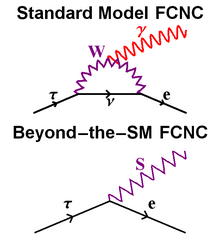|
Flavor-changing neutral current
 Below: Beyond the Standard Model tau decay via flavor-changing neutral current mediated by a new S boson.  In particle physics, flavor-changing neutral currents or flavour-changing neutral currents (FCNCs) are hypothetical interactions that change the flavor of a fermion without altering its electric charge. DetailsIf they occur in nature (as reflected by Lagrangian interaction terms), these processes may induce phenomena that have not yet been observed in experiment. Flavor-changing neutral currents may occur in the Standard Model beyond the tree level, but they are highly suppressed by the GIM mechanism. Several collaborations have searched for FCNC.[1][2][3] The Tevatron CDF experiment observed evidence of FCNC in the decay of the strange B-meson to phi mesons in 2005.[4] FCNCs are generically predicted by theories that attempt to go beyond the Standard Model, such as the models of supersymmetry or technicolor. Their suppression is necessary for an agreement with observations, making FCNCs important constraints on model-building. ExampleConsider a toy model in which an undiscovered boson S may couple both to the electron as well as the tau ( Since the electron and the tau have equal charges, the electric charge of S clearly must vanish to respect the conservation of electric charge. A Feynman diagram with S as the intermediate particle is able to convert a tau into an electron (plus some neutral decay products of the S). The MEG experiment[5] at the Paul Scherrer Institute near Zürich will search for a similar process, in which an antimuon decays to a photon and an antielectron (a positron). In the Standard Model, such a process proceeds only by emission and re-absorption of a charged In most cases of interest, the boson involved is not a new boson S but the conventional FCNCs involving the This particular example of FCNC is often studied the most because we have some fairly strong constraints coming from the decay of Experiments tend to focus on flavor-changing neutral currents as opposed to charged currents, because the weak neutral current ( See alsoReferences
|

